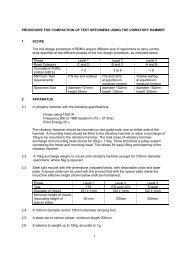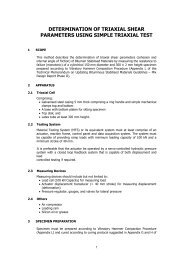Updating Bituminous Stabilized Materials Guidelines Mix Design Report Phase II
Moisture Sensitivity: Part II (Validation) - Asphalt Academy
Moisture Sensitivity: Part II (Validation) - Asphalt Academy
- No tags were found...
You also want an ePaper? Increase the reach of your titles
YUMPU automatically turns print PDFs into web optimized ePapers that Google loves.
2. METHODOLOGY<br />
2.1. MMLS3 Test Configuration<br />
Some tests initially conducted with the MMLS3 for the investigation of bituminous stabilised<br />
materials BSM’s with water exposure. This research included trafficking of nine (9) BSM-foam<br />
and BSM-emulsion specimens placed side by side in the water bath, under saturated conditions<br />
i.e. with the specimens immersed in water. The research showed that one of the major<br />
challenges with wet trafficking of BSM’s is the premature failure of the mixes after water<br />
exposure i.e. the test can require termination at less than 5000 wheel repetitions due to<br />
disintegration of the specimens, compared with similar tests on HMA that endure for 10 to 20<br />
times longer. It is a challenge therefore to develop a test protocol that provides sufficient testing<br />
time i.e. 50 000 to 100 000 wheel repetitions, to develop a sensitivity to the mix’s performance.<br />
The solutions to this challenge presented in this study as follows:<br />
Modification of MMLS3 Set-up<br />
Figure J.6 below present a schematic illustration of the MMLS3 set-up.<br />
Figure J.6: Schematic illustration of the MMLS3<br />
The MMLS3 device can apply 7200 wheel loads per hour and needs a single phase 200-240 Volt<br />
AC supply at about 1.5kW. The tyre pressure of MMLS3 can be set up to 800 kPa, during the<br />
initial tests the tyre pressure set at 650 kPa, which later adjusted to 420 kPa. This pressure is<br />
equivalent to a light truck. The reason for a reduction in tyre pressure is to minimize damage<br />
on BSMs and extend the test duration. The use of 420kPa also makes it possible to correlate<br />
MMLS3 test results with MIST device test results. An air compressor used to calibrates the tyre<br />
pressure. The wheel that used in this study is diamond tread tyres.<br />
6












